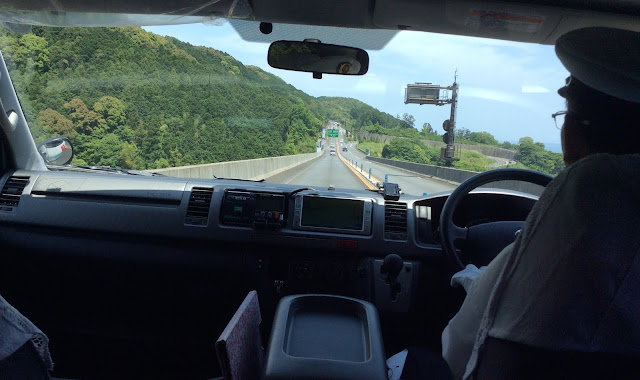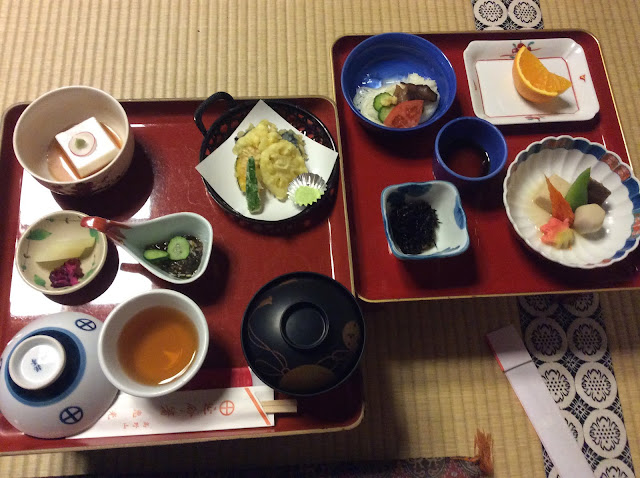The winding highway from Katsuura to Mt Koya passes through mountain roads where the scenery becomes more and more spectacular with every twist and turn. I ooh-ed and aah-ed from my window seat but had no one to share it with since everyone in the van was fast asleep.
Katsuura to Mt Koya is a mere 165 kilometers but if one takes public transportation, it would be a
7 to 9 hour journey -- and one that is totally dependent on catching the right bus or train at very specific times.
Renting a car or in our case, a spacious and comfortable van from the Shirahanko Taxi company was the most convenient way ... it took us just 3 hours to get to Koyasan.
7 to 9 hour journey -- and one that is totally dependent on catching the right bus or train at very specific times.
Renting a car or in our case, a spacious and comfortable van from the Shirahanko Taxi company was the most convenient way ... it took us just 3 hours to get to Koyasan.

It had been 4 long years since my first visit to Koyasan. Also known as the "Vatican" of Shingon
or Esoteric Buddhism, it was founded 1,200 years ago by Kobo Daishi, a Buddhist monk.
Kobo Daishi is revered all over Japan as a great Buddhist saint and his practical and wise teachings transcend all religions.
Kobo Daishi's "presence" and Koyasan's inherently serene atmosphere are like a healing balm for
my soul.
or Esoteric Buddhism, it was founded 1,200 years ago by Kobo Daishi, a Buddhist monk.
Kobo Daishi is revered all over Japan as a great Buddhist saint and his practical and wise teachings transcend all religions.
Kobo Daishi's "presence" and Koyasan's inherently serene atmosphere are like a healing balm for
my soul.
As in my first visit, we booked a one night stay at a shukubo or temple lodging. We could have chosen from any of the 50 temples that have opened their doors to guests but I decided to go back to Eko-in where Jay and I stayed the first time.
It is one of the oldest temples in Koyasan and one where the guest can experience the various practices of Shingon Buddhism like sutra writing, ajikan meditation, the rishu-zanmai-hoyo or morning sutra chanting, and the goma fire ritual.
It is one of the oldest temples in Koyasan and one where the guest can experience the various practices of Shingon Buddhism like sutra writing, ajikan meditation, the rishu-zanmai-hoyo or morning sutra chanting, and the goma fire ritual.
As you pass through the gate of Eko-in, you are greeted by this smiling henro or pilgrim. It is the sign that the temple is a shukubo and offers accommodations and meals to guests.
Eko-in's front yard has a small pond, surrounded by a riot of shrubbery.
These giant white peonies are as big as plates. Peony season has passed so these must be the late bloomers.
Two young monks lugged our large suitcases up to our second floor rooms. Our room overlooked
the front yard. A beautiful painting of mountain scenery graces the fusuma, the opaque paper
screen that separates our room from the next.
I just wanted to sit by the window and enjoy the tranquility ... I did not realise how much I had missed being here.
the front yard. A beautiful painting of mountain scenery graces the fusuma, the opaque paper
screen that separates our room from the next.
I just wanted to sit by the window and enjoy the tranquility ... I did not realise how much I had missed being here.
But, the late afternoon sun was beckoning me outdoors. I'm glad I decided to go for a walk or I may not have seen these pretty in pink tulips bobbing their heads in the breeze.
This sacred mountain used to be home to hundreds of temples of the Shingon sect of Buddhism. Today there are a little over a hundred left and half of these are shukubos, opening their ancient gates to visitors and guests.
The setting sun peeps through the masses of cedar and pine trees. A clear stream gurgles by.
I can feel my soul exhaling, I am content.
This temple is hidden at the end of a long tree lined driveway.
Come in and be refreshed, it seems to say.
We wander in and out of various temples. Each has its own distinct character but all are oases of rest for tired and busy visitors seeking respite from life's daily troubles.
Most of the temples along the main road leading to Okunoin, the sacred cemetery of Koyasan are shukubos. One is perfectly free to come in and look around the well maintained gardens.
There are no conbini stores, no McDonalds and fast food restaurants in Mt. Koya.
Instead there are small shops selling traditional sweets and delicacies. I stop to buy some of my favourites. On the left most is roppoyaki, which we know in the Philippines as "hopiang hapon".
I particularly like the bean filled pastry, second from the left, which is encased in a sweet potato dough. The kurumi-mochi rolled in a soy bean powder, reminds me very much of our own espasol, although it is a much lighter version.
Dinner at our shukubo Eko-in is set for 5:30 p.m. We hasten back to the temple so as not to be late
for the meal. Along the way, we pass by this multitude of red torii leading up to a Shinto shrine, again showing the synergistic relationship between Buddhism and the Shinto religion in Japan.
Another "hidden" shukubo, at the end of a tree lined path. Guests are also on their way back perhaps to be on time for dinner.
Dinner is shojin ryori or Buddhist traditional vegetarian cuisine. It is usually brought to your room but since there were five of us and we wanted to eat together, we were put in a private tatami room.
Cooked by the monks themselves, shojin ryori is quite a paradox -- simple flavours yet luxuriously delicious. It is plain fare made from humble everyday ingredients, yet is served in an elegant manner.
We are given two trays each -- dinner consists of sesame tofu, a specialty of Koyasan, vegetable tempura with a seasoned dipping salt, assorted tsukemono or pickles, various stewed root crops and a delicately flavoured miso soup.
In keeping with this unpretentious meal, dessert is a single slice of a sweet orange. My not so secret stash of sweets that I had bought earlier would come in handy for any sugar cravings in the middle of the night.
When we get back to the room, the monks (who also cooked the shojin ryori meal we just enjoyed) have laid out the futons in our room. The weather in Koyasan is always several degrees lower than anywhere else in the region so these quilted blankets will keep us nice and warm.
But it's not yet time to sleep -- we get our sweaters and head down to the courtyard to join the evening tour of Okunoin cemetery. This is the largest cemetery in all of Japan.
Many centuries old, it is where Kobo Daishi sits in "eternal meditation". Set in a forest of cedars and cypress trees, it is also where hundreds of thousands of tombstones can be found. Eerie or scary? Not at all ... walking through the silent tombs is soothing, the stillness is punctuated only by the "clicking" sounds made by the flying squirrels who inhabit the towering cedar trees.
While you can certainly visit the place anytime during the day, Eko-in conducts night tours, the only temple in Koyasan to do so.
Jay and I took this tour on our first visit a few years ago but we were happy to do it again.
This time, we were joined by our friends from the US who were visiting Koyasan for the very first time.
By the time the tour started at 7:15, Okunoin was completely dark save for the stone lamps lighting the path. The walk through the cemetery is a little over two kilometres from the gate to
Kobo Daishi's mausoleum -- the most sacred spot not just in the cemetery but on the entire mountain.
The tour, conducted by one of Eko-in's head monks takes about 45 minutes.
Our monk-guide did not just walk with us through the cemetery but he gave a fascinating lecture about the history of Okunoin, who were some of the more important people buried there and most importantly, he shared highlights of the wisdom of Kobo Daishi. It is a enlightening tour and one that you should not miss.
The stone lanterns along the path have cut-outs of the moon on the sides -- one shows the half moon and the other side, the full moon. Candles were used before but now, thanks to the generosity of one of the many gigantic Japanese corporations supporting Koyasan, each lantern has been fitted with an electric light bulb that casts a soft glow on the stone paths.
The bright lanterns of Eko-in guided our footsteps back to the temple. There were no cars at all along the deserted roads.
Peace and stillness enveloped the mountain. This is what I had come here for ... to refresh my distracted soul in the restful realm that is Koyasan.
Namu Daishi Henjo Kongo.
Lessons learned
1. Renting a car or hiring a taxi is the best and fastest way to get to Koyasan from any point of the Kumano Kodo pilgrimage.
2. The night tour of Okunoin conducted by Eko-in is available to guests staying in other shukubos. Make reservations
to ensure a spot on the tour.
3. All meals served in the shukubos are shojin ryori. If this is not your idea of a filling meal, there are small restaurants in Koyasan serving non vegetarian fare.
4. If you are coming from Kyoto or Osaka, the special limited express train to Koyasan is available from Namba station in Osaka.






















No comments:
Post a Comment